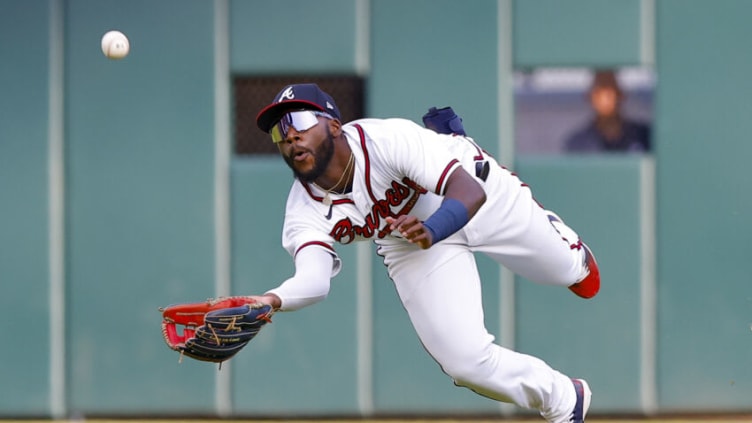Atlanta Braves: How Do Their Homegrown Bats Stack Up Across MLB?

The Atlanta Braves continue to get great production from homegrown talent, so that begs to ask the question, how do they stack up against other teams?
With the recent 8-year, $72 million contract to Michael Harris, the baseball world was reminded that the Atlanta Braves have once again struck gold with homegrown talent.
We can often get caught up in farm rankings and prospect rankings, which is fine. However, ultimately the goal is to put the best squad on the field, at any given moment that roster can only have 26 (other than double headers).
There are many different methods that have been successful over the years at constructing a competitive roster, but one that has been tried and true is developing homegrown talent, whether that is via draft or international signings.
If a team drafts well or signs international talent well, they can have good players at a cost well below market value in terms of talent per dollar. In doing so, they can use their financial flexibility to fill in other holes with free agents or trading for more expensive trade targets.
How do the Atlanta Braves stack up against other teams with homegrown talent with offense?
It is pretty obvious that the Braves have done well developing homegrown talent, with guys like Ozzie Albies, Ronald Acuña Jr., Michael Harris, Vaughn Grissom, and those are just the bats.
However, there are other teams that do well in developing homegrown talent too, like the Dodgers who have had guys like Corey Seager, Gavin Lux, Cody Bellinger (to some degree), Will Smith, etc.
So, to truly measure this, we need to set parameters. Tomahawk Take’s own Fred Owens “sat down and did the math” as they say, and figured out which teams have had the most fWAR via homegrown talent for players ages 19-28 since 2016 offensively.
When we look at the fWAR it will be for when the players were actually on their respective teams, as some of them will have been traded away or left via free agency.
As far as offense goes there have been 4 teams, the Dodgers, Cardinals, Braves, and Mets who have had the most success, so how do they stack up?
Dodgers
The Dodgers have drafted well over the years, and it has allowed them to use their massive payroll to fill in the gaps with big-name players.
Since 2016, the Dodgers’ homegrown talent has produced 67.3 fWAR if you include players that have left and only include fWAR while on the team. These numbers are led by Corey Seager (20.2), Cody Bellinger (17.2), and Will Smith (10.9).
This goes a long way in showing how the Dodgers have been able to stay competitive, and that is not just money spent.
Cardinals
The Cardinals have also done well with homegrown talent, which is something they have done for many years. This list won’t even include guys like Molina or Pujols because of the parameters set.
Since 2016, homegrown offense has produced 68.9 fWAR for the Cardinals. It is interesting because there are not huge names on their list being led by Harrison Bader (11.8), Tommy Edman (11.5), and Paul DeJong (9.5).
One thing we do know from this list is that the Cardinals love homegrown defense because all 3 of the top 3 fWAR players on the list are premier defenders.
Mets
The New York Mets may be a surprising one here since, like the Dodgers, get a lot of media attention because of their big payroll. However, they do a well above average job at developing talent offensively.
2016 has been the parameters set, and the Mets have excelled. The Mets have gotten 64.2 fWAR from their offensive players. Obviously, Pete Alonso (10.9) will be one of the headliners, but Michael Conforto (17.4) was sneaky good, and Brandon Nimmo (12.5) has done his fair share as well.
Of course, the Mets have had their ups and downs over the past few years, but developing homegrown bats has not been an issue for them.
Atlanta Braves
It is obvious to this point that the Atlanta Braves have been great at developing young talent with terms like “baby Braves” being used frequently. The proof is in the pudding that this is not just fan bias thinking that the Braves have excelled in this arena either.
At the time of this writing, since 2016, the Atlanta Braves’ homegrown offense has produced an otherworldly 107.4 fWAR, just with offensive players. These numbers are led by Freddie Freeman (28.5), Ronald Acuña Jr. (18.2), and Dansby Swanson and Ozzie Albies (both with 15).
Even if you only include Freeman’s 2016 season because that is when he was team controlled through prior to his extension, the Braves still would have a total of 85.5 fWAR from their homegrown bats since 2016.
If you take out Dansby Swanson and Ender Inciarte since they were technically traded for, you still get 79.7 fWAR
Let’s recap how the Atlanta Braves stack up
If we recap and rank homegrown offense, here is how the teams stack up:
4. Mets at 64.2 fWAR
3. Dodgers at 67.3 fWAR
2. Cardinals at 68.9
1. Braves at a whopping 107.4 fWAR (85.5 with the Freeman caveat, or 79.7 with trade caveat).
It is safe to say that the Atlanta Braves front office knows what they are doing when it comes to homegrown talent.
Next. Atlanta Braves and Max Fried Aren’t Ready to Give up the NL East. dark
All of this is just offense too. Stay tuned for pitching rankings in the near future